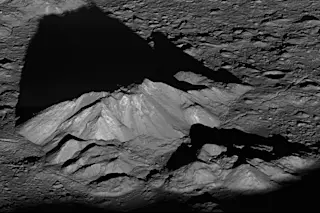The central peak of Tycho Crater on the Moon rises 6,547 feet from the crater floor in this image from the Lunar Reconnaissance Orbiter. (Source: NASA) In anticipation of the Lunar Reconnaissance Orbiter's fifth anniversary in space, NASA launched a "Moon as Art Campaign" in which the public was invited to choose a favorite orbiter image for the cover of a special image collection. And the winner is . . . The spectacular image above showing the central peak of the Tycho Crater near the southern polar region of the Moon. NASA made the announcement yesterday, exactly five years after the orbiter was launched into space from Florida, on June 18, 2009. In the oblique view above, the rugged central peak rises 6,547 feet from the crater floor; it is 9.3 miles wide from left to right. Click on the image for a larger view and look for the boulder ...
Lunar Eye Candy
Discover the stunning central peak of Tycho Crater on the Moon, rising 6,547 feet, captured by the Lunar Reconnaissance Orbiter.
More on Discover
Stay Curious
SubscribeTo The Magazine
Save up to 40% off the cover price when you subscribe to Discover magazine.
Subscribe













